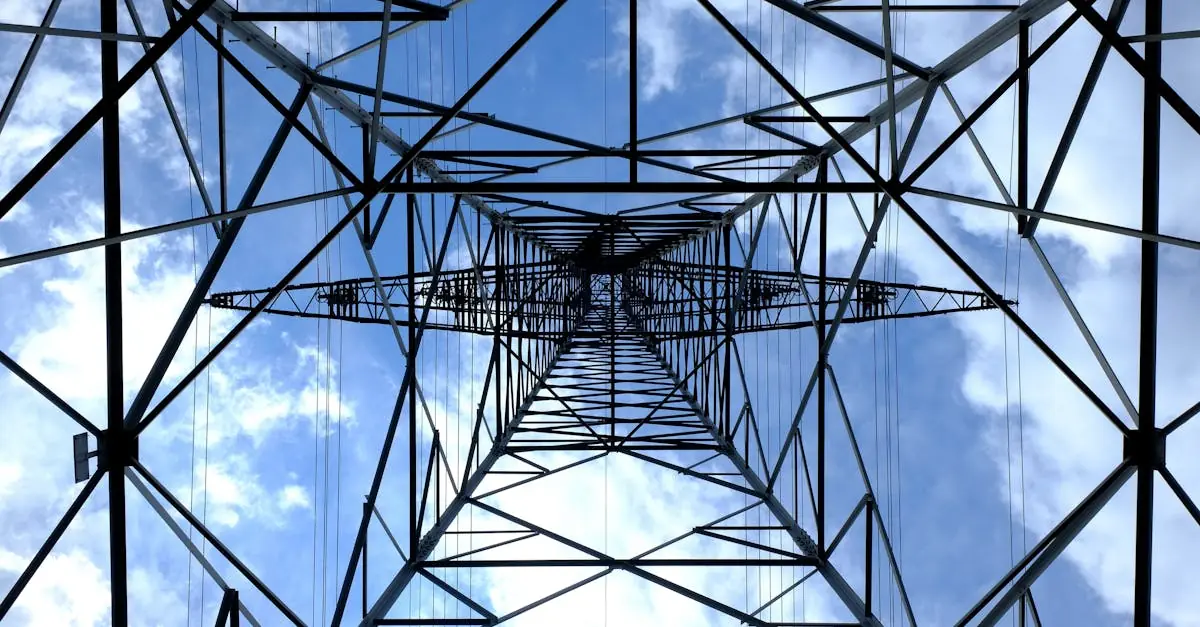In a world where Netflix can’t stream without Wi-Fi and coffee machines refuse to work without electricity, utilities are the unsung heroes of everyday life. They power homes, heat water, and keep the lights on, all while remaining in the background—like that one friend who always pays the bill but never gets invited to the party.
Understanding utilities isn’t just about knowing who to call when the lights flicker; it’s about realizing how they shape our daily routines and impact our wallets. From water to electricity to gas, these essential services can either be a blessing or a budget buster. So buckle up, because diving into the world of utilities is like opening a treasure chest filled with savings, convenience, and a sprinkle of humor. Let’s explore how to make the most of these vital services without losing our minds—or our money.
Table of Contents
ToggleOverview of Utilities
Utilities serve essential functions in everyday life, providing critical services like electricity, water, and natural gas. These services support daily activities, from cooking meals to staying warm during winter. Understanding the categories of utilities enhances one’s ability to manage household expenses effectively.
Electricity providers deliver power that fuels lighting and appliances in homes and businesses. Water utilities ensure access to clean drinking water and sanitation services. Natural gas suppliers offer heating solutions, used for both cooking and warmth. Each utility company typically operates within a specific geographic area, which means their rates and regulations can vary significantly.
Managing utility costs relies on being informed. Customers can track consumption patterns through bills and smart meters for better financial planning. Utilizing energy-efficient appliances and optimizing thermostat settings can lead to substantial savings over time. Additionally, considering alternative options like solar energy can further reduce dependence on traditional utilities.
Regularly reviewing service providers is also crucial. Customers may find more competitive rates or better services by exploring different utility companies. Incentives, such as rebates for energy-efficient upgrades, often incentivize lower usage. Those who take the time to research options will likely see a positive impact on their overall utility expenses.
Raising awareness about utilities promotes proactive engagement. When individuals are informed, they can make decisions that not only benefit their finances but also contribute to environmental sustainability. Each step taken to optimize utility use fosters a more efficient and responsible approach, enhancing daily life and reducing costs.
Types of Utilities
Utilities encompass various essential services integral to daily life. Understanding these types helps individuals manage expenses effectively.
Electric Utilities
Electric utilities deliver power to homes and businesses, supporting lighting and appliances. They typically rely on a network of power plants and transmission lines. In the U.S., the average residential electricity consumption sits around 877 kWh per month. Customers often benefit from tiered pricing, incentivizing energy conservation. Utilizing smart meters allows users to track real-time usage patterns, helping identify high-consumption periods. Exploring renewable energy options, such as wind and solar, can further reduce costs while promoting sustainability.
Gas Utilities
Gas utilities supply natural gas for heating, cooking, and water heating. This service is essential during colder months when heating needs peak. In 2020, residential customers in the U.S. averaged 61 therms per month. Many utilities offer budget billing, allowing customers to manage costs throughout the year. Monitoring gas usage on monthly bills can reveal patterns that help reduce unnecessary expenditures. Switching to high-efficiency appliances is another way to cut costs while maintaining comfort in the home.
Water Utilities
Water utilities provide clean drinking water, crucial for health and hygiene. They manage the supply from treatment plants to household taps. American households use an average of 300 gallons per day. Understanding water usage can lead to better conservation practices, particularly during droughts. Implementing low-flow fixtures and regular plumbing checks can cut excess usage. Utility providers often offer tiered rates that reward conservation through lower costs for reduced consumption.
Telecommunications Utilities
Telecommunications utilities offer services like internet, phone, and television, connecting individuals and supporting remote work. Packages vary widely, with options for bundling services. As of 2021, the average U.S. household spent about $280 monthly on these utilities. Streaming services contribute to increased bandwidth demands, leading to the need for higher-speed plans. Evaluating plans regularly ensures customers aren’t paying for unnecessary features or excess capacity. Exploring alternative providers promotes competitive pricing and better service options.
Importance of Utilities
Utilities significantly influence daily life and financial management. Understanding services such as electricity, water, natural gas, and telecommunications enhances household operations and comfort. Electricity, for instance, powers essential appliances while offering tiered pricing structures that encourage energy conservation.
Gas utilities provide valuable natural gas for heating and cooking. Monitoring gas consumption reveals patterns that allow users to identify savings opportunities. Transitioning to high-efficiency appliances increases comfort and lowers expenses, making it a practical choice for many households.
Water utilities deliver clean drinking water, essential for both health and hygiene. Recognizing water usage trends helps implement better conservation practices, especially during seasonal droughts. Installing low-flow fixtures can dramatically reduce water consumption, demonstrating the direct impact individuals can have on their utility bills.
Telecommunications utilities offer varied internet, phone, and television services. Bundling package options can streamline costs while meeting connectivity needs. Regularly reviewing service plans ensures customers avoid overpaying for features they may not use. Exploring alternative providers might reveal better pricing options and improved service quality, promoting overall satisfaction.
Proactive engagement with utilities leads to informed decisions that can benefit both finances and the environment. Tracking consumption patterns fosters awareness and encourages the adoption of energy-efficient solutions. Understanding the importance of utilities ultimately equips individuals to maximize resources and optimize household budgets.
Challenges Facing Utilities
Utilities face multiple challenges that impact their operations and service delivery. Addressing these challenges is crucial for maintaining efficiency and sustainability.
Infrastructure Issues
Aging infrastructure poses significant risks for utilities. Many companies struggle with outdated pipelines and electrical grids, which can lead to service disruptions. Regular maintenance and upgrades are necessary to prevent hazardous failures. Cybersecurity threats also endanger utility systems, making it essential to invest in protective measures. For instance, a 2022 report indicated that 40% of utilities experienced at least one cyber attack. Adopting smart technology can enhance resilience and improve operational efficiency.
Regulatory Compliance
Navigating regulatory compliance has become increasingly complex for utilities. Stricter environmental regulations require companies to adopt cleaner energy sources and reduce emissions. Compliance incurs financial costs but fosters long-term sustainability. In 2021, over 60% of utility companies reported challenges meeting new standards. Adopting best practices and proactive engagement with regulatory bodies can facilitate smoother transitions. For example, applying for grants can provide essential funding for implementing eco-friendly initiatives.
Innovations in Utilities
Innovations in utilities revolutionize how services are delivered and consumed. Recent advancements focus on efficiency, sustainability, and enhanced consumer engagement.
Smart Grid Technology
Smart grid technology optimizes energy distribution and usage. This technology uses two-way communication between utilities and consumers, boosting efficiency. Real-time data tracking enables better management of electricity flow, reducing outages. Through advanced sensors and automated systems, utilities can swiftly identify and fix problems. Enhanced response times lead to improved service reliability.
Renewable Energy Integration
Renewable energy integration reshapes traditional utility operations. Many utilities now incorporate solar and wind power into their energy mix, diversifying sources. This shift promotes environmental sustainability and energy independence. Community solar programs allow customers to participate in renewable energy, supporting local initiatives. As energy storage technologies evolve, utilities can better manage intermittent renewables, enhancing supply stability.
Conclusion
Utilities are essential to daily life and understanding their impact can lead to better financial decisions and enhanced comfort. By actively engaging with utility services and tracking consumption patterns, individuals can optimize their household budgets while contributing to environmental sustainability.
Embracing innovations like smart grid technology and renewable energy options empowers consumers to make informed choices. As utilities evolve to meet modern challenges, staying informed and proactive ensures that everyone can benefit from these critical services. Ultimately, a deeper appreciation for utilities can transform how individuals interact with them, fostering a more sustainable and economically sound future.








